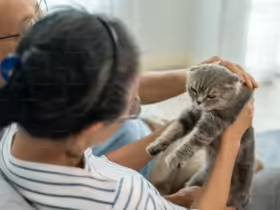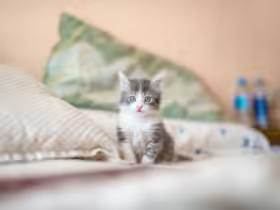Feline Leukemia Virus (FeLV) is one of the most common and serious infectious diseases affecting cats. It impacts the immune system and can lead to a variety of health problems. Understanding FeLV is crucial for cat owners to ensure early detection, effective management, and prevention. This comprehensive guide will cover what FeLV is, its symptoms, causes, diagnosis, treatment options, and how to prevent it.
What is Feline Leukemia Virus (FeLV)?
Feline Leukemia Virus (FeLV) is a retrovirus that affects cats’ immune systems, leading to immune suppression and increased susceptibility to other infections and diseases. FeLV can cause various health issues, including anemia, lymphoma, and other types of cancer. It is a serious condition that can significantly impact a cat’s quality of life.
Symptoms of FeLV
FeLV symptoms can vary widely, making it challenging to identify the virus based solely on symptoms. Common signs include:
- Loss of Appetite: A noticeable decrease in appetite or reluctance to eat.
- Weight Loss: Unexplained weight loss despite a normal or increased food intake.
- Lethargy: Excessive tiredness or lack of energy.
- Fever: Persistent or recurrent fever not related to other infections.
- Persistent Respiratory Issues: Coughing, sneezing, or nasal discharge.
- Gastrointestinal Problems: Vomiting, diarrhea, or gastrointestinal discomfort.
- Skin Problems: Poor coat condition, skin infections, or unusual hair loss.
- Anemia: Pale gums and other signs of anemia due to decreased red blood cells.
- Swollen Lymph Nodes: Enlarged lymph nodes, which can be a sign of lymphoma or other cancers.
Causes of FeLV
FeLV is caused by a retrovirus that is spread through close contact between infected and healthy cats. The primary routes of transmission include:
- Saliva: FeLV can be spread through bites, grooming, or sharing food and water bowls.
- Urine and Feces: The virus can be present in urine and feces, though this is a less common mode of transmission.
- Nasal Secretions: Sneezing or coughing can potentially spread the virus.
- Mother to Kittens: FeLV can be transmitted from an infected mother cat to her kittens during pregnancy or through nursing.
- Shared Items: Shared bedding or litter boxes may also pose a risk, although this is less common.
Diagnosing FeLV
Early diagnosis is crucial for managing FeLV effectively. Diagnostic methods include:
- Blood Tests:
- ELISA Test: The Enzyme-Linked Immunosorbent Assay (ELISA) test detects FeLV antigens in the blood. It is the most common initial test for diagnosing FeLV.
- IFA Test: The Immunofluorescence Assay (IFA) test detects FeLV antigens in white blood cells and is used to confirm positive ELISA results.
- Clinical Examination: A thorough physical exam to assess the cat’s overall health and check for symptoms related to FeLV.
- Blood Work: Additional blood tests may be done to evaluate organ function and detect anemia or other abnormalities.
- Imaging Studies: X-rays or ultrasounds may be used to check for tumors or other complications associated with FeLV.
Treatment Options for FeLV
There is no cure for FeLV, but treatment focuses on managing symptoms and improving the cat’s quality of life. Treatment options include:
- Supportive Care:
- Nutritional Support: A balanced diet tailored to the cat’s needs can help maintain health and energy levels.
- Hydration: Ensuring the cat stays hydrated is essential, especially if they are experiencing gastrointestinal issues.
- Medications:
- Antiviral Drugs: Some antiviral medications may help reduce the viral load and improve immune function.
- Immunomodulators: Medications that help boost the immune system can be beneficial.
- Symptomatic Treatment: Medications to manage symptoms such as pain, fever, or infections.
- Regular Vet Visits: Frequent veterinary check-ups to monitor the cat’s health, manage symptoms, and adjust treatment as needed.
- Isolation: To prevent the spread of the virus to other cats, keeping an FeLV-positive cat indoors and separate from other pets is recommended.
Managing Life with a FeLV-Positive Cat
Caring for a cat with FeLV involves several important considerations:
- Maintaining a Clean Environment: Regularly clean litter boxes, food dishes, and bedding to minimize the risk of secondary infections.
- Monitoring Health: Keep an eye on your cat’s health and behavior, and report any changes to your veterinarian.
- Reducing Stress: Minimize stressors in the cat’s environment to help support their immune system.
Preventing FeLV
Preventing FeLV involves measures to reduce the risk of exposure and infection:
- Vaccination: Vaccination is available and can help protect cats from FeLV. Consult your veterinarian about the best vaccination schedule for your cat.
- Testing and Isolation: Test new or at-risk cats for FeLV before introducing them to other cats. Isolate any FeLV-positive cats to prevent the spread of the virus.
- Avoiding High-Risk Situations: Keep your cat indoors to limit exposure to potentially infected cats and avoid contact with stray or unknown cats.
Conclusion
Feline Leukemia Virus (FeLV) is a serious and complex condition that requires careful management and prompt veterinary care. Understanding the symptoms, causes, and treatment options can help you provide the best possible care for your cat. Regular veterinary visits, appropriate vaccinations, and a well-managed environment are key to supporting the health and well-being of cats affected by FeLV.










Leave a Reply